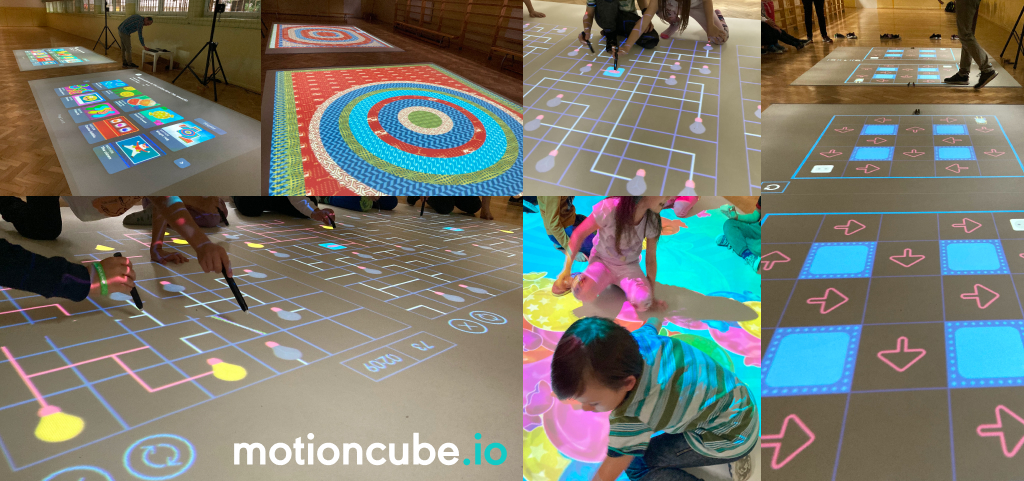Use Motioncube apps for your coding classes! Below is the scenario and summary of the coding workshop as part of EU Code Week Poland, which took place at a primary school in Krakow in October 2023. The classes were conducted by representatives of LavaVision, creators of the Motioncube applications.
Objective of the course: Introduction to the basics of algorithms in the form of games and activities on the interactive floor.
Target group: students aged 8
Duration: 90 minutes
Course of classes
Warm-up:
As part of introducing and learning about the technology, we offered students free interaction on the floor with animations reacting to movement.
Free movement fun using the For Fun collection applications:
- on magic rugs that changed under the influence of the movement of students' bodies,
- with soap bubbles that burst when stepped on,
- with candies that appeared after movement.
We explained to the participants the basic principle of operation of an interactive projector that displays an image on the floor surface: the camera records movement on the surface, and the software analyzes the image from the camera and sends a modified image to the projector for display.
Then, using IR light pens, students solved logical puzzles, the aim of which was:
- connecting all the bulbs to the power supply to turn them on (the Light on! application from the Head First collection).
To make it easier to work with a group of 22 students, we divided them into two subgroups (we had two interactive floors at our disposal), and these into pairs. In total, there were 5-6 pairs of students per floor. The possibility of dividing the projection area into three boards enabled three teams to work on each floor simultaneously. After solving the board, another team took turns.
Main activity:
The main activities were based on solving interactive coding boards from the Dot Bot game collection, using IR light pens. We displayed two large boards on each floor, and students continued to work in pairs to solve the tasks.
1. Game: Bot Code
The students had to analyze the given arrow code and determine the new position of the virtual robot on the board. With each subsequent board, the task difficulty increased, the instructions were longer and additional events appeared on the board. Some students used an auxiliary prop - a wooden block, that they placed on the board's squares to simulate following instructions.
2. Game: Arrow Plan
On maze boards completely covered with directional arrows, students had to choose those leading the robot to the exit. After marking the correct route, the robot navigated the maze.
3. Game: Bot Job
Students programmed the Bot to work! They arranged the instructions for his route using arrows to lead him to the exit. Remembering that the Bot's task is to turn on the light bulbs, collect all the screws, recharge the battery and repair the devices.
End of the workshop:
The participants of the classes relaxed while playing freely in the interactive water with swimming fish. We ended the workshop with this nice and soothing activity.
Summary
During the coding workshop, we used two interactive projectors with Motioncube inside using applications from the following collections: For Fun, Head First and Dot Bot. The projection areas were divided into several boards to enable teams to work simultaneously.
Conclusions:
MOVEMENT - positive aspects
The ability to move during classes greatly motivates children to engage in activities. It triggers creativity in them because they start moving in ways they rarely have the opportunity to try daily. They test their ideas for different positions, change the pace of movement, and express their emotions loudly. We do not need scientific evidence to conclude that physical play (which we observed on the interactive floor) causes a lot of joy and positive reactions (both in those who move and in those who observe it).
PAIR CODING - efficient practice
The pair programming method, known in the programming community and promoted in software engineering textbooks (especially agile programming, AGILE) for over twenty years, is efficient during classes on the interactive floor. Working together on the same board to compose the code goes much faster for students when they help each other by sharing tasks: e.g. one player reads the character's position, the other writes it down, or one player describes the selected route in words (e.g. two down, collect, one to the left, turn on etc.), the other writes it down using graphic symbols. With such cooperation, code creation goes like clockwork. Suppose there is an error in the code. In that case, finding it together is much easier than searching it alone: one player reads the written instruction, while the other follows its execution on the board, mentally moving around the fields or moving an auxiliary prop.
PROPS - SOS for imagination
In the initial tasks, we asked students to use wooden blocks, which they moved across the fields of the board, according to the visible instructions. This was intended to make it easier for them to understand how the robot moves around the fields, what the individual instructions mean, and also to help them "not lose" the position of the robot when working independently, reading the instructions and locating the character's position on an ongoing basis.
DIVISION INTO TEAMS - there is no time for boredom
To enable smooth and fair participation in classes for a large group, it is best to divide them into smaller teams that rotate after each task. Additionally, we recommend dividing the projection area into several boards (2-3-4 depending on the application) to allow several teams to participate simultaneously.
Useful links:
- Dot Bot - a collection of games and activities with algorithms for IR pens
- Head First - a collection of logic games for IR pens
- For Fun - a collection of physical games
- LavaVision - designer of Motioncube applications
- Interactive floor - interactive projection system
Motioncube.io


